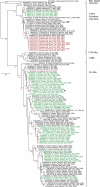Wild bird trade at live poultry markets potentiates risks of avian influenza virus introductions in Iran
- PMID: 34777715
- PMCID: PMC8583743
- DOI: 10.1080/20008686.2021.1992083
Wild bird trade at live poultry markets potentiates risks of avian influenza virus introductions in Iran
Abstract
Wild aquatic birds are the main natural host reservoir of avian influenza viruses (AIV). Migratory aquatic birds can translocate AI viruses over wide geographic distances. AIV may be transmitted reciprocally at the wild bird-poultry interface, increasing viral variability and potentially driving the zoonotic potential of these viruses. A cross-sectional study on AIV and several further avian viral pathogens conducted in 396 trapped migratory aquatic birds traded at live bird markets (LBM) in northern Iran identified 11 AIV-positive cases. The 10 identified H9N2 viral sequences fell into wild bird H9 lineage Y439; in addition, an H10N3 virus of Eurasian lineage was detected. Ten samples contained low viral loads of avian coronavirus but could not be further characterized. Although traditional trading of live-trapped wild birds provides income for hunters, particularly during fall migration periods, it increases the risk of introducing new AIV strains from the natural reservoir to poultry kept at LBMs and, potentially, to traders and customers. Banning these birds from poultry trading lines would lower such risks considerably.
Keywords: Avian influenza; Iran; Zoonosis; live bird market; poultry; wild birds.
© 2021 The Author(s). Published by Informa UK Limited, trading as Taylor & Francis Group.
Conflict of interest statement
No potential conflict of interest was reported by the author(s).
Figures

References
-
- World Health Organization . A guide to healthy food markets. Guidelines. Geneva: The Organization; 2006; [cited 2021 Jul 21]. Available from: https://apps.who.int/iris/bitstream/handle/10665/43393/9241593938_eng.pdf
-
- Yee KS, Carpenter TE, Mize S, et al. The live bird market system and low-pathogenic avian influenza prevention in southern California. Avian Dis. 2008;52(2):348–7. - PubMed
-
- Olsen B, Munster VJ, Wallensten A, et al. Global patterns of influenza a virus in wild birds. Science. 2006;312(5772):384–388. - PubMed
LinkOut - more resources
Full Text Sources
